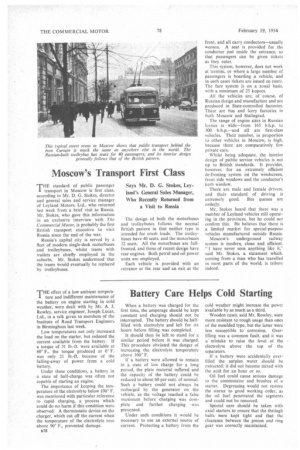Battery Care Helps Cold Starting
Page 52

If you've noticed an error in this article please click here to report it so we can fix it.
THE effect of a low ambient tempera
ture and indifferent maintenance of the battery on engine starting in cold weather, were dealt with by Mr. A. J. Rowley, service engineer, Joseph Lucas, Ltd., in a talk given to members of the Institute of Road Transport Engineers in Birmingham last week.
Low temperatures not only increased the load on the starter, but reduced the current available from the battery. If a torque of 31 lb.-ft. were available at 60° F., the torque produced at 0° F. was only 21 lb.-ft. because of the falling-away of power from a cold battery.
Under these conditions, a battery in a state of half-charge was often not capable.of starting an engine.
The importance of keeping the temperature of the electrolyte below 100° F. was mentioned with particular reference to rapid charging, a process which could do no harm if this condition were observed. A thermostatic device on the charger, which cut off the current when the temperature of the electrolyte rose above 90° F., prevented damage.
al8 When a battery was charged for the first time the amperage should be kept constant and charging should not be interrupted. The battery should be halffilled with electrolyte and left for six hours before filling was completed.
It should then be left to stand for' a similar period before it was charged. This procedure obviated the danger of increasing the electrolyte temperature above 100° F.
If a battery were allowed to remain in a state of low charge for a long period, the plate material suffered and the capacity of the battery could be reduced to about 60 per cent. of normal. Such a battery could not always be recharged by the generator on the vehicle, as the voltage reached a false maximum before charging was complete and further charging was prevented.
Under such conditions it would be necessary to use an external source of current. Protecting a battery from the cold weather might increase the power available by as much as a third.
Wooden caseS, said Mr. Rowley, were more resistant to rough usage than ones of the moulded type, but the latter were less susceptible to corrosion. Overfilling was a common fault, and it was a' mistake to raise the level of the electrolyte above the top of the separators.
If a battery were accidentally overfilled the surplus water should be extracted: it did not become mixed with the acid for an hour or so.
Oil fuel could cause serious damage to the commutator and brushes of a starter. Degreasing would not restore the starter to good working order, as the oil fuel penetrated the segments and could not be removed.
Special care should be taken with axial starters to ensure that the through bolts were kept tight and that the clearance between the pinion and ring gear was correctly maintained.




























































































